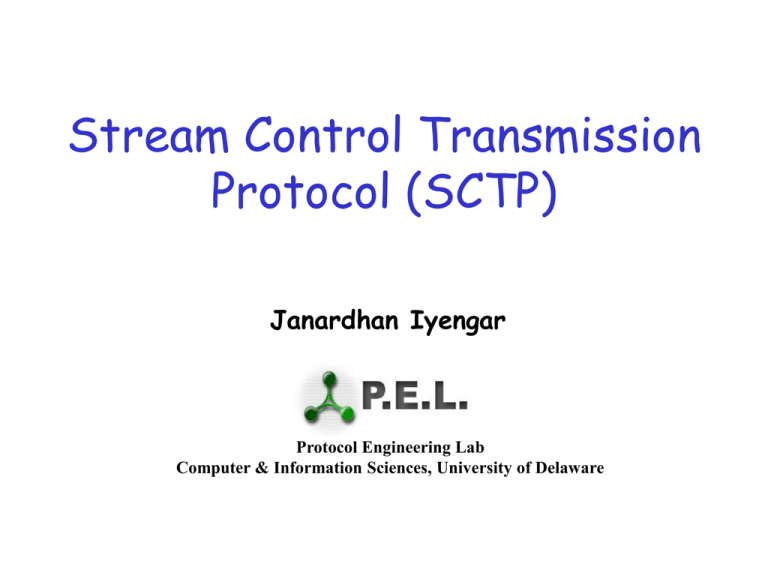- Computer and Information Sciences
advertisement

Stream Control Transmission
Protocol (SCTP)
Janardhan Iyengar
Protocol Engineering Lab
Computer & Information Sciences, University of Delaware
Where is SCTP in the stack?
application
application
Transport UDP TCP SCTP DCCP UDP
lite
UDP TCP SCTP DCCP UDP
lite
IP
IP
IP
CHAOS !
IP
IP
IP
IP
A Brief History
Primary motivation: Transportation of telephony
signaling messages over IP networks
1997
RFC 3309
MDTP work
Sep. 2002
began
1992-1997
Oct. 2000
UDP Reliability
SCTP - RFC2960
Experiments
1991
TCP Failure
RFC 3257
RFC 3436
Apr. 2002
Dec. 2002
1998
MDTP submission
RFC 3286
(UDP based)
May 2002
RFCs
•
•
•
•
•
•
RFC 2960 – Stream Control Transmission Protocol
RFC 3257 - SCTP Applicability Statement
RFC 3286 - An introduction to SCTP
RFC 3309 – SCTP Checksum Change
RFC 3436 – Transport Layer Security over SCTP
RFC 3758 – SCTP Partial Reliability Extension
Origins:
SCTP – History
Public Telephone Network Signaling
SS7 over IP (IETF Sigtran working group)
Bakeoffs
Current home: IETF TSVWG
(Transport Services Working Group)
– IETF recognizes broader scope
– Proposed Standard - RFC2960
Supported by industry:
•
•
Munich
Date
Attend
6/00
12
10/00
22
Sophia Antipolis
4/01
19
San Jose (Connectathon)
2/02
6
U. of Essen (Germany)
9/02
20
U of Delaware
6/03
11
Muenster (Germany)
7/04
Research Triangle Park
Participation in Bakeoffs: ADAX - Cisco – HP/Compaq - Data Connection
- DataKinetics - Ericsson - Hughes Software - IBM - Motorola –
Netbricks - Nokia - Open SS7 - Performance Technologies - RadiSys Siemens – Spider - Sun Microsystems - Telesoft Technologies - Toshiba Ulticom -Wipro
Implementations: AIX, FreeBSD, Linux, QNX, Solaris, True64,
IOS (Cisco Routers), Sony PlayStation II, Mac OS, more…
SCTP Feature Summary
Start with TCP:
reliable (retransmissions)
congestion controlled
connection oriented
Add:
4-way handshake
to reduce vulnerability to DOS attacks
framing
preserve message boundaries
multistreaming
instead of one ordered stream,
up to 64K independent ordered streams
multihoming
instead of one IP address per endpoint
a set of IP addresses per endpoint
TCP Connection Setup
A
t=0
1RTT
B
SYN Flooding Attack
attackers
128.3.4.5
192.10.2.8
130.2.4.15
victim
SYN
228.3.14.5
SYN
190.13.4.1
221.3.5.10
SYN
Flooded!!
TCB
TCB
TCB
TCB
TCB
Unavailable, reserved resources
• There is no ACK in response to the SYN-ACK, hence connection
remains half-open
• Other genuine clients cannot open connections to the victim
• The victim is unable to provide service
SCTP Association Setup
A
t=0
1RTT
2RTT
B
What’s in a cookie?
•
•
•
•
•
Information from original INIT
Information from current INIT-ACK
Timestamp
Life span of cookie (Time to live)
Signature for authentication (SHA-1,
MD5, etc.)
Graceful Shutdown
App signals
shutdown
A
B
Shutdown
pending
Shutdown
sent
Shutdown
received
Shutdown-Ack
sent
Closed
Closed
SCTP Feature Summary
Start with TCP:
reliable (retransmissions)
congestion controlled
connection oriented
Add:
4-way handshake
to reduce vulnerability to DOS attacks
framing
preserve message boundaries
multistreaming
instead of one ordered stream,
up to 64K independent ordered streams
multihoming
instead of one IP address per endpoint
a set of IP addresses per endpoint
Message Boundaries
• UDP honors message boundaries
– Each app message becomes a datagram
• TCP does not honor message boundaries
– App messages become part of a byte stream
• SCTP maintains message boundaries
– Each app message is maintained as one or
more data chunks
Chunks in SCTP
Source Port
Destination Port
Verification Tag
SCTP
PDU
Common Header
Checksum
Chunk 1
Chunks
Chunk N
• Building blocks of an SCTP PDU
• Two kinds – control chunks and data chunks
• data chunks are smallest atomic data units
SCTP Chunk Format
Type
Flags
Length
Chunk Data
•Type – e.g. Data, Init, SACK
•Flags – bit meanings depend on type
•Length – includes type, flags, length,
and data/parameters
Some Chunk Types
0x00
DATA
User data
0x01
INIT
~ SYN
0x02
INIT-ACK
0x03
SACK
Selective ACK
0x04
HEARTBEAT
Keep-alive message
0x05
HEARTBEAT-ACK
0x07
SHUTDOWN
0x08
SHUTDOWN-ACK
~FIN
Data Chunk
0
31
Type =
0x00
Flags = UBE
Length
Transmission Sequence Number (TSN)
Stream Identifier (SID)
Stream Seq. Num. (SSN)
User supplied Payload Protocol Identifier
User Data
SACK Chunk
0
31
Type = 0x3
Flags = 0
Length = variable
Cumulative TSN acknowledgement
Advertised receiver window
Num. Gap ACK blocks = N
Num. duplicates = X
Gap ACK blk #1 start TSN offset
Gap ACK blk #1 end TSN offset
........
Gap ACK blk #N start TSN offset
Gap ACK blk #N end TSN offset
Duplicate TSN 1
……..
Duplicate TSN X
Offset is relative to cumulative TSN.
GAP ACK blocks are blocks received after cum TSN.
Chunk Bundling in SCTP
Source Port
SCTP
PDU
Destination Port
Verification Tag
Checksum
Common Header
Chunk 1
Bundling
Chunk N
•
•
•
•
Multiple chunks in one SCTP PDU
Control chunks bundled before data chunks
Chunk boundary cannot cross SCTP PDU boundary
Optional at sender, but receiver has to support
Fragmentation/Reassembly in SCTP
Large messages are fragmented and encapsulated
into several data chunks
Reassembled before delivery to receiving app
U
B E
Description
*
1
0 (Begin) First Piece of fragmented message
*
0
0 Middle piece of fragmented message
*
0
1 (End) Last piece of fragmented message
*
1
1 Non-fragmented message
*U set to 1 specifies unordered message
Note: Fragmentation req. – sequential TSN’s
Fragmentation Example
E.g. Message for Stream 2 from app exceeds PMTU.
Stream 2 message
U=0, B=1,
E=0
TSN=
6
SID=
2
SSN=1
First data frag.
Part of Data Chunk Header
U=0, B=0,
E=0
TSN=
7
SID=
2
SSN=1
Second data frag.
U=0, B=0,
E=1
TSN=
8
SID=
2
SSN=1
Last data frag.
Upon completion, Stream Sequence Number increments
SCTP Feature Summary
Start with TCP:
reliable (retransmissions)
congestion controlled
connection oriented
Add:
4-way handshake
to reduce vulnerability to DOS attacks
framing
preserve message boundaries
multistreaming
instead of one ordered stream,
up to 64K independent ordered streams
multihoming
instead of one IP address per endpoint
a set of IP addresses per endpoint
Head-of-Line Blocking in TCP
1S
2
3
4
5
6
R’s App
R
ACK 2
ACK 3
1
2
ACK 3
ACK 3
ACK 3
PDU 3 is blocking
the head of the line.
Head-of-line Blocking
• TCP provides a single data stream
• When a segment is lost, subsequent segments
must wait to be processed.
• Problem for some applications (telephony)
• SCTP provides multiple independent streams per
association
SCTP Multistreaming
• Logical separation of data within an assoc
• Designed to prevent head-of-line blocking
• Can be used to deliver multiple objects belonging to the
same assoc
– Eg: objects on a webpage, multimedia streams
(audio/video/text), files in an FTP mget
Head-of-Line Blocking in SCTP
S
App Layer
SID :SSN
1:1
3:1
1:2
3:2
1:3
2:1
1:4
2:2
3:3
(all ordered streams)
TSNs
1,2
3
4,5,6
7,8,9
R
Transport Layer
App Layer
SID :SSN
1:1, 3:1
1:2
3:2, 1:3, 2:1
1:4, 2:2, 3:3
ACK 2
1:1, 3:1
undelivered
ACK 2
3:2, 2:1
ACK 2
2:2, 3:3
NOTE: An SCTP ACK a
cum ack based onTSN.
SCTP Feature Summary
Start with TCP:
reliable (retransmissions)
congestion controlled
connection oriented
Add:
4-way handshake
to reduce vulnerability to DOS attacks
framing
preserve message boundaries
multistreaming
instead of one ordered stream,
up to 64K independent ordered streams
multihoming
instead of one IP address per endpoint
a set of IP addresses per endpoint
What is SCTP Multihoming?
A1
ISP
A2
ISP
Internet
ISP
B1
ISP
B2
Host A
•
Hosts pick 1 of 4 possible TCP connections:
―
•
Host B
{(A1, B1), (A1, B2), (A2, B1), (A2, B2)}
Hosts use 1 SCTP association:
–
–
–
–
({A1,A2}, {B1,B2})
Selectable “primary” dest: Host A → B1 ; Host B → A1
New data sent only to primary destination
Path status and reachability monitored (hearbeats)
SCTP Multihoming
• Why important?
• multihoming is now happening on wide scale
• wired + wireless, multiple ISPs, etc.
• Key Research Problems
• fault tolerance
• load sharing (concurrent transfer)
SCTP Research at PEL
Concurrent Multipath Transfer (CMT)
With
With
CMT
With
TCP
Existing
current Paths
SCTP
Internet
Path 1
ISP
1
ISP
4
Path 2
ISP
2
ISP
3
ISP
5
Path 3
ISP
6
CMT Protocols
•
CMTnaive
•
•
•
SCTP (RFC 2960) with 1 modification
modified SCTP to send new data to all destinations concurrently
significant reordering observed
•
•
•
•
•
Causes unnecessary fast retransmits
Causes incorrect cwnd growth
Where should retransmissions be sent ?
What should sender do if paths intersect ?
CMTsmart
•
CMTnaive with 3 proposed algorithms*
•
•
•
•
•
split fast retransmit (“SFR-CACC”) algorithm
cwnd update (“CUC”) algorithm
delayed ack (“DAC”) algorithm
Retransmissions sent to destination with largest ssthresh
…
• http://www.cis.udel.edu/~iyengar/publications/
SCTP Retransmission Policy
• Current retransmission policy
– Retransmit to an alternate destination, if exists
– Attempts to improve chances of success
– No prior research to demonstrate benefits
– this policy degrades performance in many cases
• Alternate solutions
• Retransmit to same dst
• Fast retransmit to same dst, Timeouts to alternate dst
• Multiple Fast Retransmit Algorithm
• …
• www.armandocaro.net/papers/
SCTP Failover: Parameter Settings
• Investigate and improve performance during failover
• How do you decide when to failover to an alternate path?
– Default parameter settings and algorithms in SCTP
take too long
– This work investigates alternate parameter settings
and algorithms
• www.armandocaro.net/papers/
Transparent SCTP Shim
• Migrate existing TCP applications to SCTP transparently
• Application gains: fault tolerance, SACK support
http://www.cis.udel.edu/~bickhart/research.html
Other PEL Contribution
• SCTP module for ns-2 (in ver 2.27 or greater) – most
widely used network simulator in research community
– downloaded and used by several researchers
– part of coursework / course projects (UCLA, TAMU, UF, …)
• SCTP module for tcpdump (in ver. 3.7 or greater)
• Available at http://pel.cis.udel.edu
Services/Features
SCTP
TCP
UDP
Connection-oriented
yes
yes
no
Full duplex
yes
yes
yes
yes
proposed
yes
no
no
no
Flow control
yes
yes
no
TCP-friendly congestion control
yes
yes
no
ECN capable
yes
yes
no
Ordered data delivery
yes
yes
no
Unordered data delivery
yes
no
yes
Uses selective ACKs
yes
optional
no
Path MTU discovery
yes
yes
no
Application PDU fragmentation
yes
yes
no
Application PDU bundling
yes
yes
no
Preserves application PDU boundaries
yes
no
yes
Multistreaming
yes
no
no
Multihoming
yes
no
no
Protection against SYN flooding attack
yes
no
n/a
Allows half-closed connections
no
yes
n/a
Reachability check
yes
yes
no
no (uses vtags)
yes
yes
for vtags
for 4-tuple
n/a
Reliable data transfer
Partial-reliable data transfer
Pseudo-header for checksum
Time wait state
Resources
• Randall R. Stewart, Qiaobing Xie, 2002, “Stream Control
Transmission Protocol (SCTP) A Reference Guide
• Stewart et. al., Stream Contol Stream Transmission
Protocol RFC-2960, October 2000.
URL: http://www.ietf.org/rfc/rfc2960.txt
• Ong L. and J. Yoakum, May 2002, “An Introduction to
the Stream Control Transmission Protocol (SCTP)”
URL: http://www.ietf.org/rfc/rfc3286.txt
• Caro Jr. et al, “SCTP: A Proposed Standard for Robust
Internet Data Transport”, November 2003, IEEE
Computer
http://www.eecis.udel.edu/~amer/PEL/poc/index.html#pubs
• Protocol Engineering Lab: http://pel.cis.udel.edu
Questions ?
Extra slides
Outline
those who
know TCP
SCTP
research
those who have
taken networks
What is
SCTP ?
those in
computer science
What is a
transport
protocol ?
brief personal comments
those in the
audience
What are the
components of
the Internet ?
Research Project I:
Improving FTP Using SCTP Multistreaming
File Transfer Protocol
control connection
FTP
client
FTP
server
data connection
n+1 TCP connections
Classic FTP over TCP
Client
Server
PORT
200
NLST
SYN
SYN-ACK
ACK
150
FIN
FIN-ACK
226
ACK
200
PORT
SIZE
213
RETR
SYN
SYN-ACK
ACK
150
FIN
226
ACK
DATA
FIN-ACK
Redundant
round trips
Using multistreaming in FTP
FTP
client
control stream
data stream
FTP
server
1 SCTP association
FTP over TCP
Client
FTP over multistreamed SCTP
Server
Client
Server
FTP over multistreamed
SCTP with command
pipelining
Client
Server
PORT
200
NLST
SYN
SYN-ACK
ACK
150
NLST
150
150
DATA
DATA
226
DATA
213
FIN-ACK
150
PORT
DATA
ACK
226
200
SIZE
213
RETR
SYN
SYN-ACK
DATA
FIN
226
SIZE
213
RETR
226
150
226
SIZE
FIN
ACK
NLST
SIZE
213
150
RETR
RETR
DATA
226
FTP over multistreamed
SCTP
Client
Server
stream 0
NLST
150
stream 0
stream 0
SIZE
stream 0
213
RETR
stream 0
150
DATA
Server
NLST
stream 0
stream 1
stream 0
stream 0
stream 1
150
Name List
stream 0
stream 0
226
226
Client
stream 1
Name List
stream 0
FTP over multistreamed
SCTP with command
pipelining
stream 0
stream 0
stream 0
stream 0
226
SIZE
SIZE
RETR
213
213
RETR
150
DATA
stream 0
stream 0
stream 0
stream 1
stream 0
226
Experimental Setup
bandwidth = BW delay = D
FTP
client
Traffic shaper
bandwidth = BW delay = D
Bandwidth-Delay Configurations:
1Mbps-35ms : US end-to-end coast
256Kbps-125ms : Satellite communication
3Mbps-1ms : UAV communication
Loss probability: {0, .01, .03, .06, .10}
Loss probability distribution: Uniform
File sizes: {10K, 50K, 200K, 500K, 1M}
Number of files transferred: {10, 100}
FTP
server
configuration:
1Mbps - 35ms
End-to-End configuration:
BW = 1Mbps,
RTT = 70ms
configuration:
256Kbps - 125ms
End-to-End configuration:
BW = 256Kbps,
RTT = 250ms
End-to-End configuration:
BW = 1Mbps,
RTT = 70ms
End-to-End configuration:
BW = 1Mbps,
RTT = 70ms
Results
FTP over SCTP with multistreaming/pipelining
• dramatically reduces end-to-end latency in multiple
file transfers, and in a TCP-friendly manner
• reduces the server load (by decreasing the number
of connections)
• reduces the network load
• maintains simplicity at the application



